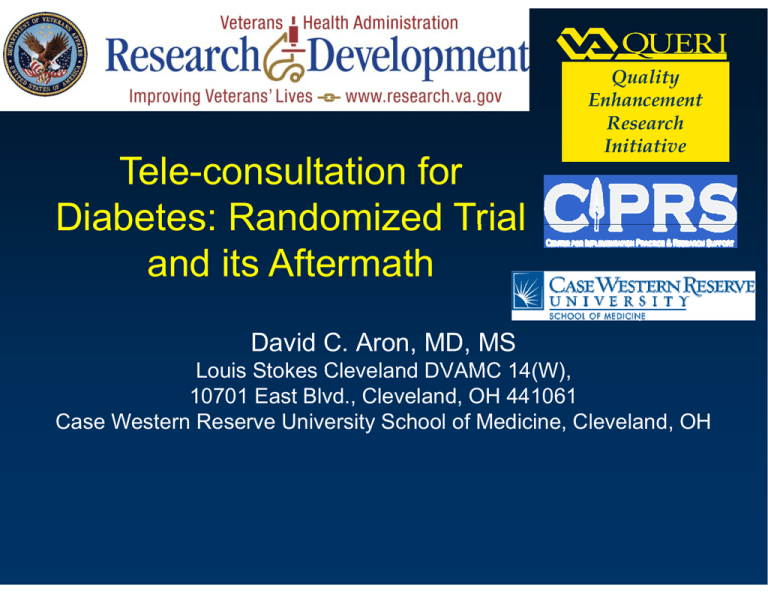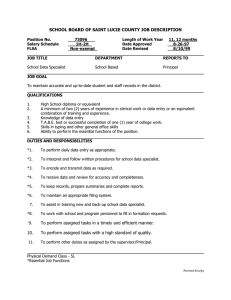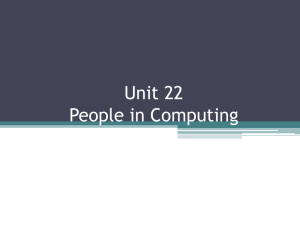Tele-consultation for Diabetes: Randomized Trial and its Aftermath David C. Aron, MD, MS
advertisement

Tele-consultation for Diabetes: Randomized Trial and its Aftermath Quality Enhancement Research Initiative David C. Aron, MD, MS Louis Stokes Cleveland DVAMC 14(W) 14(W), 10701 East Blvd., Cleveland, OH 441061 Case Western Reserve University School of Medicine, Cleveland, OH Background Rapid increase in primary care in general primary care in general Rapid increase in primary care delivered primary care delivered in community‐based outpatient clinics p (CBOCs) Access to specialist Access to specialist expertise increasingly problematic: limited numbers of specialists; longer distances from primary care i 2 Aims • compare the impact of outreach consultation through using joint-clinics via teleconferencing to the usual consultation process on self-efficacy and clinical outcomes t • compare processes and change in processes associated with the specialist joint-clinic joint clinic teleconsultations to usual outpatient consultation process. • evaluate l t short-term h tt medical di l care utilization tili ti and d costs t associated with the intervention. joint clinic teleconsultation • compare the impact of DM joint-clinic to usual consultation process on outcomes related to providers’ care of other patients with DM. Conceptual Model based on Clinical Microsystems Macro‐organizational System Clinical Microsystem Patient PC T PC Team INTERVENTION: and Patient PC Team System JOINT‐CLINICS PCP VIA TELE‐ CONFERENCING CBOC Cleveland VAMC Specialist Expertise Macro‐organizational System Clinical Microsystem Usual referral process involving p g consult at tertiary center (Cleveland VAMC) Patient PC Team and Patient PC Team System PCP CBOC Cleveland VAMC Note Relevance to Patient-Centered Medical Home OUTCOMES PCP Team and Patient Level: Patient (Cohort I) ‐Care Care Satisfaction Satisfaction ‐Care Self‐Efficacy ‐Clinical Outcomes Patient Cohort II ‐Clinical Outcomes PCP ‐Diabetes Treatment Efficacy ‐ Night‐time regimen management PC Team ‐Diabetes Treatment Efficacy Cleveland VAMC Waiting time ‐ Waiting time for referrals CBOC Microsystem Level: Changes in structure and processes of care processes of care (e.g., inter‐ dependence of the care team) ‐ Referral rates Costs Methods • Population: Patients referred to Diabetes Clinic ((staffed by y Endocrinologists) g ) • Setting: 11 Community-based outpatient clinics linked to a tertiary care center center. • Design: Randomized Controlled Trial – CBOCs randomization stratified by size. • Measures and Analyses – Mixed Methods Usual Referral Process for Patients with Diabetes PCP visit: i it decide need diabetes specialist i li t Wed. Clinic Referral made Thursday Clinic FFriday id Clinic Initial Assess‐ ment: Patient meets with ih Team Notes entered into CPRS for PCP (first visit includes alert to notify referring PCP) Team Confers Confers without patient: Develops Plan of Plan of Care Patient travels to VAMC Clinics: Team Approach ( (includes Endocrinologist, CDE/RN,& PharmD, / and, on Thursdays, Residents) Team explains Care Plan Plan to Patient and modify as needed Follow‐ up Visits at at VAMC (6‐8 visits usually/ at 4‐6 week intervals) INTERVENTION Process for Patients with Diabetes PCP visit: decide need diabetes specialist Referral made JOINT‐ CLINIC at CBOC: PCP Team, Patient & Diabetes i b Expert Team Joint Initial Assess Assess‐ ment PC Team/ Patient System D l Develops Plan of Care (patient i l d d) included) Follow‐ up Visits at t CBOC as needed Patient Doesn’t Return Goal Reached Back to PCP at CBOC Goal Not Reached (but unlikely to benefit further from clinic visits) Joint Clinic Telemedicine Intervention Joint-Clinic • O One half-day/month h lf d / th for f each h CBOC ~ 6 patients/session • Conducted by an endocrinologist and a diabetes nurse education/ specialist. • The primary care teams (including PCP and nurse) were invited to participate in the telemedicine intervention. • F/U endocrinology specialist visits involving the teleconsultation group took place via teleconferencing. teleconferencing Results Demographics Intervention i Controll mean+SD / % mean+SD / % 61 54+9 5 61.54+9.5 61 31+9 8 61.31+9.8 ns gender (male) 90.50% 98.80% ns race (white) race (white) 69 30% 69.30% 75 90% 75.90% ns education (some college) 57.30% 63.90% ns marital status (married) 49.70% 67.50% ns income (<$40,000/yr) 63.80% 59.00% ns Lives with someone 65.80% 79.50% ns age p Baseline Intermediate Clinical Outcomes Intervention Control mean range mean range p Baseline A1c 10.1 6.4 - 14.9 9.32 Baseline Creatinine 1.18 .6 - 4.3 1.31 .6 - 6.7 ns Baseline LDL 101.49 33 - 241 100.04 46 - 258 ns Baseline B li S Systolic t li Baseline Diastolic 128 34 128.34 93 - 198 131 46 131.46 102 - 184 ns 71.91 40 - 98 70.31 45 - 90 ns 5.3 - 15.9 P=0.05 Other Characteristics at Baseline Baseline. • There were no differences in comorbidities (coronary artery disease and heart failure). • The control group had more end-organ damage (p=0.052), specifically neuropathy and retinopathy (p<0 001) (p<0.001). • There were no differences in baseline use of insulin, glucosidase inhibitors, inhibitors and thiazolidinediones thiazolidinediones, but intervention patients were more likely to be using sulfonylureas and biguanides (p<0 (p 0.001). 001) • There were no differences in self-rated health, barriers to self-care self care, self-efficacy self efficacy or treatment satisfaction satisfaction. Qualitative Analysis of Baseline Interviews • 22 interviews • themes: – prior to the telemedicine intervention the referral of the diabetic patient to an endocrinologist was essentially a “black black box box” for the CBOC CBOC, in that they would make the referral and were then unsure what appe ed from o tthe e pat patient e t pe perspective. spect e happened – When asked about the impending telemedicine intervention, respondents p were g generally yp positive, but unease about uncertainty and concern about logistics. Results: Intermediate Clinical Outcomes of Diabetes Care • Patients in the intervention (teleconsultation) group had a greater decrease in A1c values than those in th control the t l ((usuall consultation) lt ti ) group ((-1.14% 1 14% and d -0.64%, respectively, p=0.098). • There was a significant difference in the change in systolic blood pressure: -4.5 and +3.9mmHg for i t intervention ti and d control t l groups respectively ti l (p<0.005). • There were no significant changes in LDLcholesterol or serum creatinine. Patient Reported Outcomes • Ease of communication with the specialist – no difference; (97.2% of the usual care group felt that that were no difficulties in communication with the specialist vs vs. 98 98.8% 8% in the teleconsultation group). • Degree of difficulty seeing the specialist - no differences, b t difficulty but diffi lt h hearing i th the specialist i li t was lless ffrequentt iin th the usual care group (1.4% vs 13.3%, p=0.004). • patients in the teleconsultation group responded positively to a question about whether the specialist was able to understand their situation more frequently than those in the usual care group (97.0% vs 88.4%, p=0.009). p 0.009). • In the teleconsultation group, 99.3% agree that telemedicine made it easier to get medical care and <2% would have preferred to see the specialist in person person. Patient Reported Outcomes • Satisfaction with visits ((veryy satisfied or somewhat satisfied)) were the same in both groups (76.6% vs 76.7% for usual care vs. teleconsultation, respectively), though the proportion of patients who were very satisfied with the consultation was greater in the teleconsultation group (61.2%,) compared to usual care (40 (40.8%) 8%) - p=0.004). p=0 004) • Patients in the teleconsultation group were more (very) comfortable with the number of providers (83 (83.0%) 0%) vs usual care (72.3%) - p<0.001). • Usual care patients were more likely to disagree or strongly disagree with the statement that they benefited from the specialist visit (14.1%) vs teleconsultation (2.4%) - p p<0.001. 0.001. Qualitative Analysis of Post Intervention Interviews: Theme: Changes in Referral Process • Travel was a significant issue and it is important to note the burden placed on the patients for getting themselves to the consultation visit at the VAMC. – “I would ld say less l than th 10% off our patients ti t would ld be b willing illi tto b be referred to Wade Park because of the distance. It’s just really a cumbersome situation.” [Nurse] • Th The llack k off d desire i ffor ttravell tto Wade W d Park P k to t see a specialist also had the potential to lead to fragmented care for the patient, who would chose a local, non VAaffiliated specialist, specialist and then come to the CBOC for medication. “ – See, a lot of them don’t have a problem with their primary care provider id b being i att th the VA b butt th they d don’t ’t wantt tto go Cl Cleveland l d ffor their specialist.” [Nurse] Qualitative Analysis of Post Intervention Interviews: Theme: Alignment of Role and Training • D During i the th intervention, i t ti another th change h occurred: d each h CBOC has a nurse (usually a certified diabetes educator) to handle most of the more complicated p diabetes p patients. – “At one time we did not have a diabetic case manager here and really, it was hard… Because the patients need to be seen more than once every three months. months If you start seeing them more than once every three months your schedule is so bogged down doing something that should be done by somebody who is not paid as much money, you know, instead of me being the diabetic educator educator.” [PCP] • Post intervention: Primary care physicians also expressed satisfaction in being able to “hand hand over” over diabetic patients that needed more attention to the nurses. The nurses reported increased satisfaction associated with having a greater role in caring i ffor patients. ti t The Th telemedicine t l di i iintervention t ti iis an education intervention for the participants. Qualitative Analysis of Post Intervention Interviews: Other Themes • Communication – Complaints about communication before the telemedicine • Patient Focused Care – Care is provided in a setting familiar to the patient and the consultation results in better communication for the entire care team. “It means more patient to hear it from the specialist. p I could have been telling g to the p them for years about what they need to do, but as soon as they hear it from the specialist on the t.v., it means something.” [PCP] – “The patients seem to like the t.v.! It’s me, the patient, the NP, and the physician. Four people focused on the patient – the patient feels like they are getting a lot of attention.” [Nurse] • Patient Care / Compliance with Care Plan – In the post-intervention interviews, providers related stories that support the current process that uses telemedicine consultation, but PCPs expressed frustration with patient compliance that hasn’t hasn t changed over the study period. Summary y • consultation between a patient with diabetes and a specialist spec a st tea team by te teleconferencing eco e e c g is s feasible, eas b e, co consistent s ste t with principles of the Patient Centered Medical Home, and at least as good as consultation in person. • many positive changes resulting from teleconsultation. To quote a PCP: – “From From my personal experience experience, this has been an excellent change. It’s a win-win situation for providers and for patients.” • This project also illustrates some of the challenges in accomplishing that, especially in determining attribution of effects. The implementation of the telemedicine project played out while a variety of other diabetes-related interventions were going on; fortunately, the interventions applied equally to control and intervention sites. The best proof that the intervention “worked” • Aft After the th intervention i t ti phase h was completed, l t d the th intervention CBOCs as a group DEMANDED that the service be continued and the control CBOCs DEMANDED that they be given equal access. access • Teleconsultation is now one of the ways we do business. business Consolidated Framework for Implementation Research – CFIR (Damschroder et al.) Intervention Individuals Involved Individuals Involved PCPS dropped out early on (adapted Specialist MD only) Ad daptable Periphery Co ore Compon nents Oth I t Other Interventions ti Intervention Co ore Compon nents Adaptable Periiphery (unadapted Specialist MD and RN) Outer Setting Inner Setting DM Case Managers Process Improved Nurse/PCP Communication Both in CBOC and between CBOC and Med Ctr Remember: There is NO SUCH THING AS A BEST PRACTICE … INDEPENDENT OF THE CONTEXT IN WHICH IT IS CONDUCTED. Key Part of the Context: Thanks to: Ajay Sood, MD, Sharon Watts, RN, DNP, CDE, Katherine Thweatt, PhD, Stacey Hirth, Jan Solomon, Scott Ober, MD, MBA and others.





